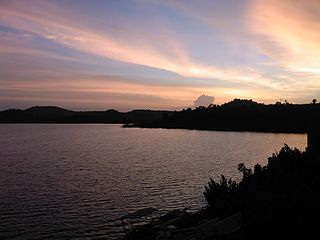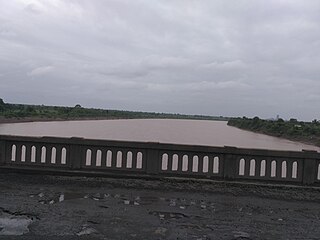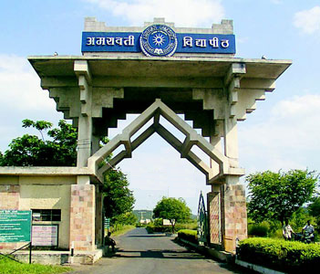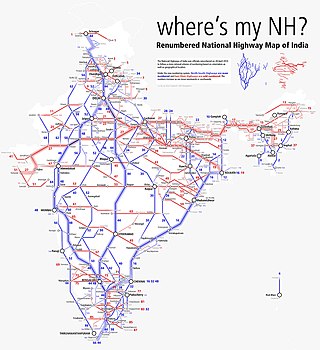Vidarbha is a geographical region in the east of the Indian state of Maharashtra and a proposed state of western India, comprising the state's Amravati and Nagpur divisions. Amravati Division's former name is Berar. It occupies 31.6% of the total area and holds 21.3% of the total population of Maharashtra. It borders the state of Madhya Pradesh to the north, Chhattisgarh to the east, Telangana to the south and Marathwada and Uttar Maharashtra regions of Maharashtra to the west. Situated in central India. The largest city in Vidarbha is Nagpur followed by Amravati, Akola, Chandrapur and Gondia. A majority of Vidarbha residents speak Varhadi and Zadi dialects of Marathi.

Yavatmal district, [jəʋət̪maːɭ] formerly known as Yeotmal, is a district of the Indian state of Maharashtra. It is located in the region of Vidarbha, in the east-central part of the state. It is Vidarbha's third-largest district by population, after Nagpur and Amravati. Yavatmal city is the administrative headquarters of the district.

Amravati district is a district of Maharashtra state in central India. It is the administrative headquarter of Amravati division, which is one of the two divisions in Vidarbha, out of total 6 regions in state of Maharashtra.

Yavatmal ( is a city and municipal council in the Indian state of Maharashtra. It is the administrative headquarters of Yavatmal District. Yavatmal is around 90 km away from divisional headquarters Amravati while it is 670 km away from the state capital Mumbai and 150 km south west of Nagpur. Yavatmal District is on 2nd position in India after Kolkata and known for its unique Navratri festival celebration, and nearly total 2,766+ durga mata is installed in the whole district. Yavatmal is known for organising huge celebration events for Navratri.

Washim district is a district in Maharashtra, India. The headquarters is at Washim. The area of the district is 5,150 km2 (1,990 sq mi).

Mahur or Mahurgad is a town and religious place in Nanded district of Maharashtra, India. Mahur is the birthplace of Hindu God Dattatreya. Dattatreya parents Atri Rishi and Sati Anasuya Mata lived here. Brahmadev, Vishnudev and Lord Shiva once got a news about Anusaya Mata that there is no one more pious and pure as her. To test her piousness they arrived under the garb of asking Alm (bhiksha). Near Mahur, There is a Pious confluence of River Penganga and River Pus at Hiwara Sangam village, Tal. Mahagaon Vidarbha, from where the river flows northward. Penganga river forms a border between Vidarbha and Marathwada. Mahur falls just about 3kms inside Marathwada due to river banks.

Amravati Division, also known as Varhad, is an Indian one of the six administrative divisions of Maharashtra state in India. Amravati and Nagpur divisions constitute the ancient Vidarbha region. Amravati Division is bound by Madhya Pradesh state to the north, Nagpur Division to the east, Telangana state to the southeast, Marathwada region to the south and southwest, and Nashik Division to the west.
Pandharkawda is a City and a Municipal council in Yavatmal district in the Indian state of Maharashtra. The Pandharkawada municipality won "Best Municipality at Amravati Division" in 2006 and a quality of education award in 2011. It is near the Saikheda Dam, an earthfill dam on the Khuni River..
Risod is a city and a municipal council in Washim district in the Indian state of Maharashtra. Risod is also a major market place for the people from Hingoli district as well as Risod tahsil.

Wani is a 3rd largest city in Yavatmal district in the Indian state of Maharashtra.
Mahagaon is located in Pusad subdivision of Yavatmal district in the state of Maharashtra, India.
Ralegaon is Tehsil place town in Yavatmal District of Maharashtra (India). It is located in Vidarbha region of Maharashra. Geographically it is located northwest from Yavatmal. It is located 42 km away from Yavatmal and 21 km away from the Kalamb which is on Nagpur-Yavatmal road. And just 41 km from city Wardha.

The Painganga River is the chief river of the Buldhana district, Hingoli district, Nanded district, Yavatmal district, Chandrapur district and Washim district in the Maharashtra state in India. It flows along the southeast boundaries of the district in a winding, meandering course. It is deeply entrenched and difficult to navigate. It rises in the Ajantha range and is a major tributary of the Wardha River, the other major river in the district. It is also divided Marathwada and Vidarbha near Umarkhed and Himayatnagar.

The Berar Division, formerly Berar Province, was one of the former administrative divisions of the Central Provinces and Berar of British India. Ellichpur (Achalpur) was the capital and the administrative headquarters of the division.
Upper Pus Dam, also called Pus Dam is an earthfill dam on Pus river near Pusad, Yavatmal district in the state of Maharashtra in India. There is another downstream dam near Mahagaon called Lower Pus Dam which was built in 1983. Other nearby dams are Arunawati Dam in Digras built in 1994 and Isapur Dam built in 1982.
Lower Pus Dam, is an earthfill dam on Pus river near Mahagaon, Yavatmal district in state of Maharashtra in India. There is another downstream dam near Pusad town called Upper Pus Dam which was built in 1971. Other nearby dams are Arunawati Dam in Digras built in 1994 and Isapur Dam built in 1982.

Babasaheb Naik College of Engineering (BNCoE), Pusad, founded in 1983, is a not-for-profit engineering college run by the Janta Shikshan Prasharak Mandal, located at Pusad, Yeotmal District in Vidarbha region of the state of Maharashtra, India.

National Highway 161,, is a National Highway in India running through the states of Maharashtra and Telangana of India. The National Highway 161 joins the cities of Akola, Washim, Hingoli, Nanded, Degloor, Bichkunda, Pitlam, Nizampet, Shankarampet(A), Jogipet, Sanga Reddy.
National Highway 161A, commonly as NH 161A, is a National Highway running through states of Karnataka and Maharashtra, with a total length 507 Kilometres that connects Akot, Maharashtra to Bidar, Karnataka. National Highway 161A joins the cities of Akot, Akola, Barshitakli, Mangrulpir, Manora, Digras, Arni, Mahur, Kinwat, Himayatnagar, Mudkhed, Waghala, Mukhed, Maharashtra–Karnataka border in central southern India with each other. It is an auxiliary route of National Highway 61.
Wardha–Yavatmal–Nanded line is an under-construction railway project based in Maharashtra, India. The railway line would facilitate the transport between Wardha to Nanded via Yavatmal. The Ministry of Railways, Government of India has given the project a "special project" status. The railway line would operate on a geographical area of 284 kilometers.

















